change time SSANGYONG TURISMO 2013 Service Manual
[x] Cancel search | Manufacturer: SSANGYONG, Model Year: 2013, Model line: TURISMO, Model: SSANGYONG TURISMO 2013Pages: 796, PDF Size: 78.99 MB
Page 198 of 796
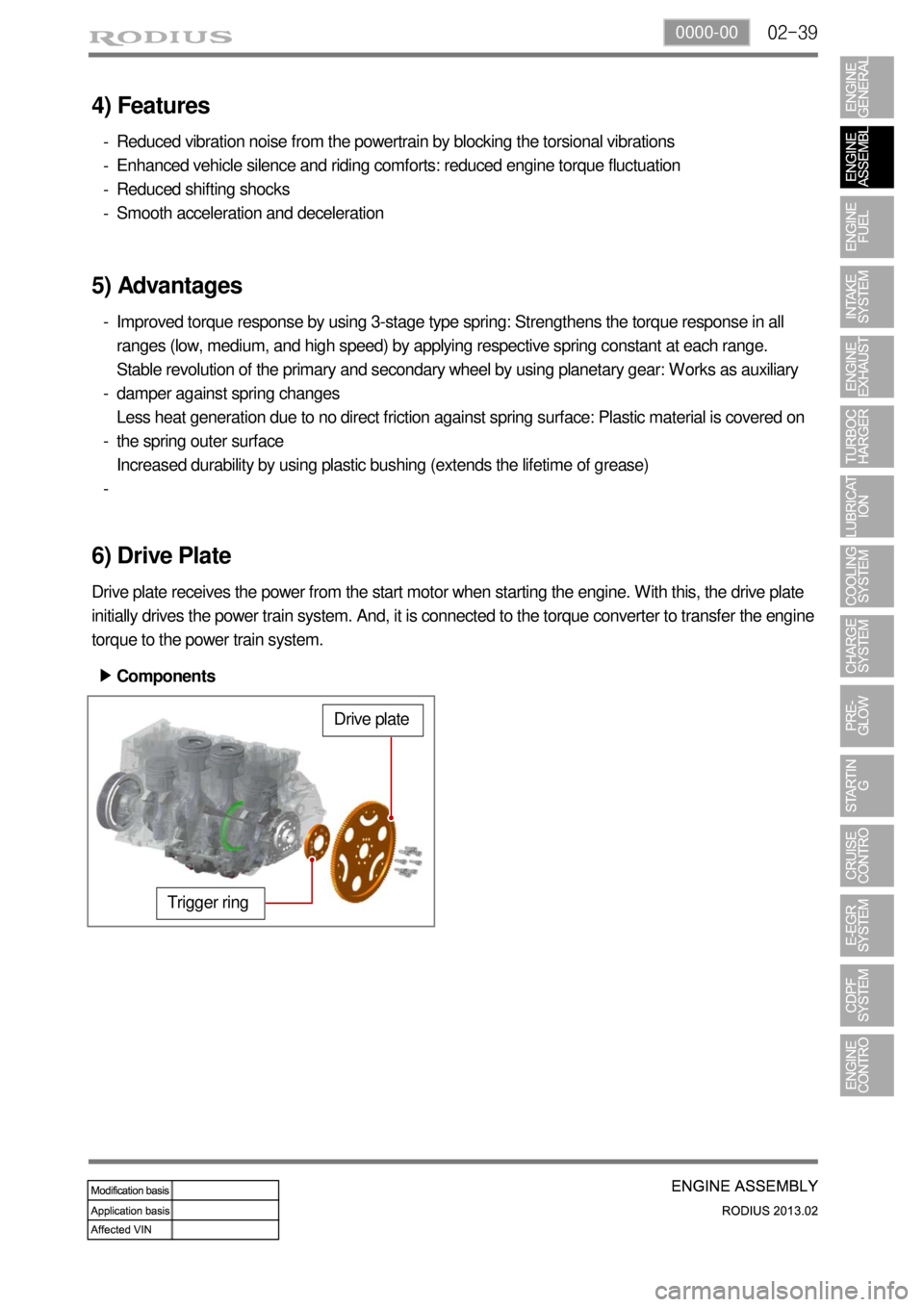
02-390000-00
4) Features
Reduced vibration noise from the powertrain by blocking the torsional vibrations
Enhanced vehicle silence and riding comforts: reduced engine torque fluctuation
Reduced shifting shocks
Smooth acceleration and deceleration -
-
-
-
5) Advantages
Improved torque response by using 3-stage type spring: Strengthens the torque response in all
ranges (low, medium, and high speed) by applying respective spring constant at each range.
Stable revolution of the primary and secondary wheel by using planetary gear: Works as auxiliary
damper against spring changes
Less heat generation due to no direct friction against spring surface: Plastic material is covered on
the spring outer surface
Increased durability by using plastic bushing (extends the lifetime of grease) -
-
-
-
6) Drive Plate
Drive plate receives the power from the start motor when starting the engine. With this, the drive plate
initially drives the power train system. And, it is connected to the torque converter to transfer the engine
torque to the power train system.
Trigger ring
Drive plate
Components ▶
Page 268 of 796
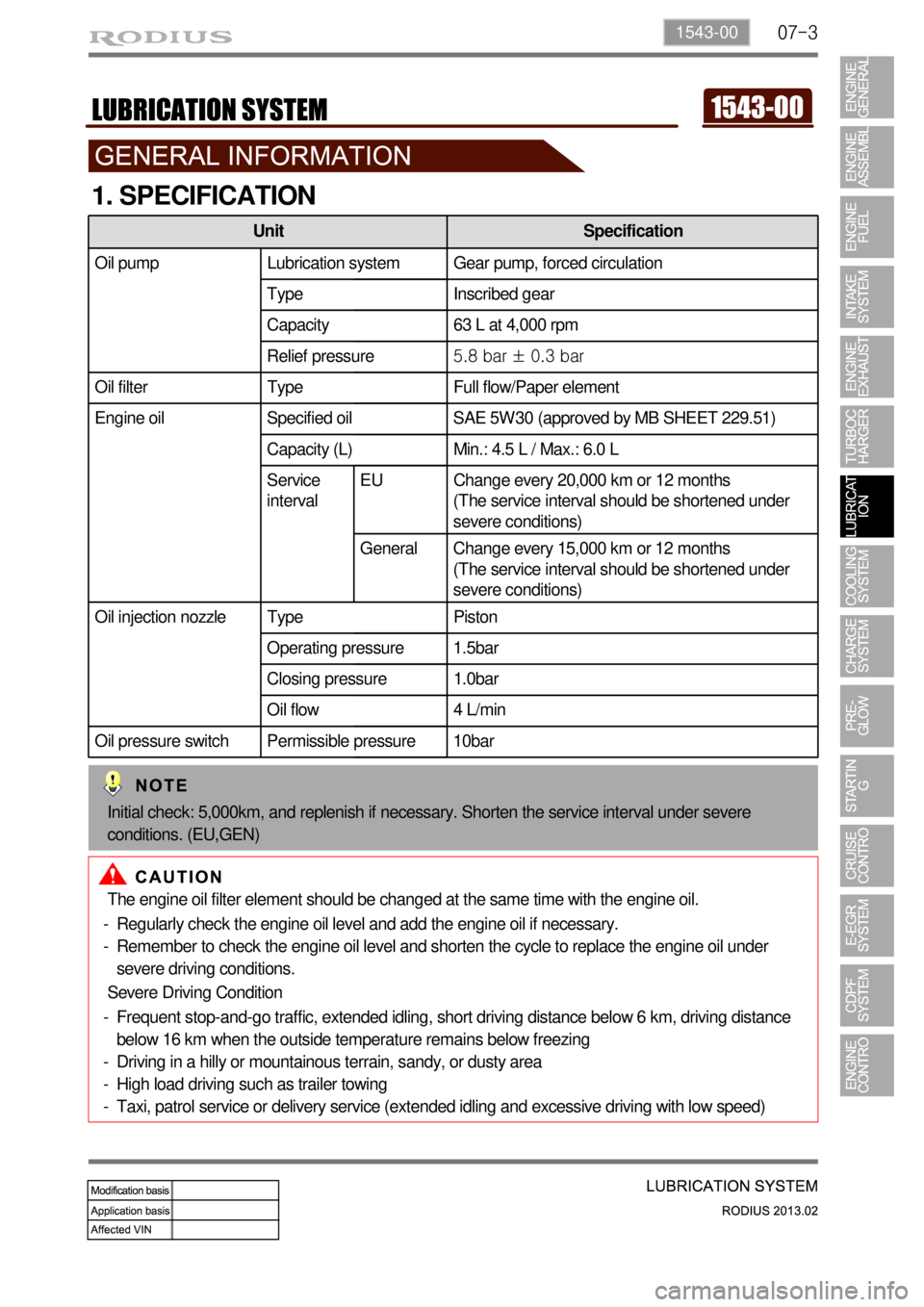
07-31543-00
1. SPECIFICATION
The engine oil filter element should be changed at the same time with the engine oil.
Regularly check the engine oil level and add the engine oil if necessary.
Remember to check the engine oil level and shorten the cycle to replace the engine oil under
severe driving conditions. -
-
Severe Driving Condition
Frequent stop-and-go traffic, extended idling, short driving distance below 6 km, driving distance
below 16 km when the outside temperature remains below freezing
Driving in a hilly or mountainous terrain, sandy, or dusty area
High load driving such as trailer towing
Taxi, patrol service or delivery service (extended idling and excessive driving with low speed) -
-
-
-
Unit Specification
Oil pump Lubrication system Gear pump, forced circulation
Type Inscribed gear
Capacity 63 L at 4,000 rpm
Relief pressure5.8 bar ± 0.3 bar
Oil filter Type Full flow/Paper element
Engine oil Specified oil SAE 5W30 (approved by MB SHEET 229.51)
Capacity (L) Min.: 4.5 L / Max.: 6.0 L
Service
intervalEU Change every 20,000 km or 12 months
(The service interval should be shortened under
severe conditions)
General Change every 15,000 km or 12 months
(The service interval should be shortened under
severe conditions)
Oil injection nozzle Type Piston
Operating pressure 1.5bar
Closing pressure 1.0bar
Oil flow 4 L/min
Oil pressure switch Permissible pressure 10bar
Initial check: 5,000km, and replenish if necessary. Shorten the service interval under severe
conditions. (EU,GEN)
Page 339 of 796
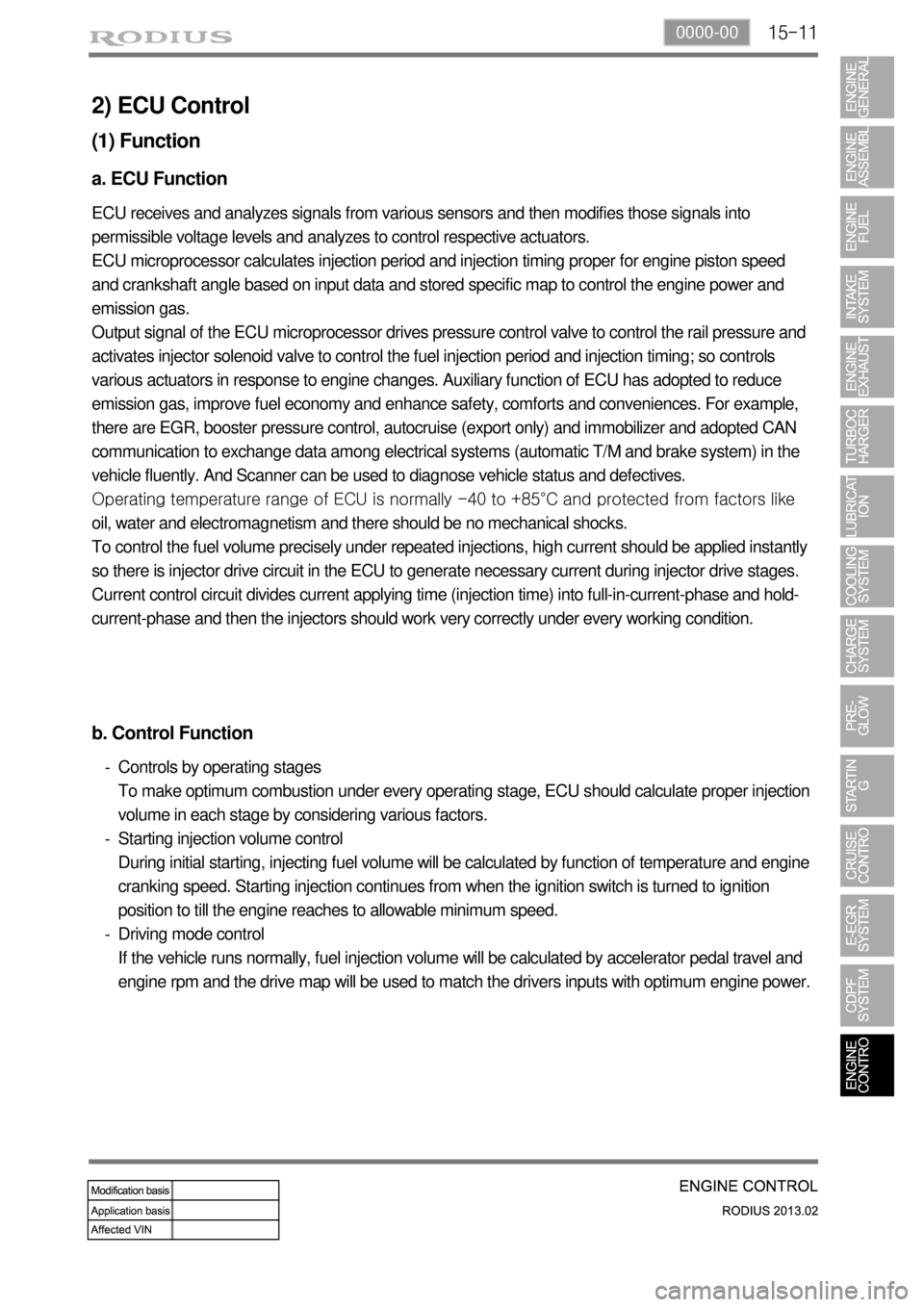
15-110000-00
2) ECU Control
(1) Function
a. ECU Function
ECU receives and analyzes signals from various sensors and then modifies those signals into
permissible voltage levels and analyzes to control respective actuators.
ECU microprocessor calculates injection period and injection timing proper for engine piston speed
and crankshaft angle based on input data and stored specific map to control the engine power and
emission gas.
Output signal of the ECU microprocessor drives pressure control valve to control the rail pressure and
activates injector solenoid valve to control the fuel injection period and injection timing; so controls
various actuators in response to engine changes. Auxiliary function of ECU has adopted to reduce
emission gas, improve fuel economy and enhance safety, comforts and conveniences. For example,
there are EGR, booster pressure control, autocruise (export only) and immobilizer and adopted CAN
communication to exchange data among electrical systems (automatic T/M and brake system) in the
vehicle fluently. And Scanner can be used to diagnose vehicle status and defectives.
Operating temperature range of ECU is normally -40 to +85°C and protected from factors like
oil, water and electromagnetism and there should be no mechanical shocks.
To control the fuel volume precisely under repeated injections, high current should be applied instantly
so there is injector drive circuit in the ECU to generate necessary current during injector drive stages.
Current control circuit divides current applying time (injection time) into full-in-current-phase and hold-
current-phase and then the injectors should work very correctly under every working condition.
b. Control Function
Controls by operating stages
To make optimum combustion under every operating stage, ECU should calculate proper injection
volume in each stage by considering various factors.
Starting injection volume control
During initial starting, injecting fuel volume will be calculated by function of temperature and engine
cranking speed. Starting injection continues from when the ignition switch is turned to ignition
position to till the engine reaches to allowable minimum speed.
Driving mode control
If the vehicle runs normally, fuel injection volume will be calculated by accelerator pedal travel and
engine rpm and the drive map will be used to match the drivers inputs with optimum engine power. -
-
-
Page 345 of 796

15-170000-00
A fourth correction is made according to the pressure error.
This correction is used to reduce the injection timing advance when the pressure in the rail is higher
than the pressure demand.
A fifth correction is made according to the rate of EGR.
This correction is used to correct the injection timing advance as a function of the rate of exhaust
gas recirculation. -
-
When the EGR rate increases, the injection timing advance must in fact be increased in order to
compensate for the fall in termperature in the cylinder.
A. Main Flow Control
The main flow represents the amount of fuel injected into the cylinder during the main injection. The
pilot flow represents the amount of fuel injected during the pilot injection.
The total fuel injected during 1 cycle (main flow + pilot flow) is determined in the following manner.
When the driver depress the pedal, it is his demand which is taken into account by the system in
order to determine the fuel injected.
When the driver release the pedal, the idle speed controller takes over to determine the minimum
fuel which must be injected into the cylinder to prevent the enigne from stalling. -
-
The driver demand is the translation of the pedal position into the fuel demand. It is calculated as a
function of the pedal position and of the engine speed. The driver demand is filtered in order to limit the
hesitations caused by rapid changes of the pedal position. A mapping determines the maximum fuel
which can be injected as a function of the driver demand and the rail pressure. Since the flow is
proportional to the injection time and to the square root of the injection pressure, it is necessary to limit
the flow according to the pressure in order to avoid extending the injection for too long into the engine
cycle. The system compares the driver demand with this limit and chooses the smaller of the 2 values.
The driver demand is then corrected according to the coolant temperature. This correction is added to
the driver demand.
(5) Fuel Control
B. Driver Demand
Page 434 of 796

02-38710-01
1. SPECIFICATIONS OF RK - STICS
1) Electrical Performance
2) Chattering of Input Signals
Vehicle speed input:
The vehicle speed calculating time is 1.0 seconds. The elapsed time of 1.5 seconds after IGN
1 switch :ON” is not included.
20 ms target input:
Wiper motor A/S (parking) terminal
100 ms target input switch
All switches except wiper motor A/S (parking) terminal 1.
2.
3.
3) Time Tolerance
If not indicated, time tolerance will be ± 10%.
However, if less than 500 ms, time tolerance will be ± 50 ms.
The time indicated in each function does not include chattering processing time from switch
input changing point. 1.
2.
Item Requirement Remark
Rated voltage DC 12 V
Operating voltage DC 9 to 16 V Should operate normally within this range.
Operating temperature-30℃ ~ +80℃
Reserved temperature-40℃ ~ +85℃
Max. operating humidity 95%
Resistible voltage 24 V
Insulating resistance No heat and fire due to
the current leaks.Confined with PCB, waterproof and coating that
requires the insulation.
Parasitic current below 4.0 mA
(below 6.0 mA)IGN = OFF, Full output load = OFF, 90
seconds (after received the signals), No input
changes for 2 seconds
Voltage drop below 1.2 V
below 2.0 VPin no. 8 and 2, 3, 5, 7, 10, 12, 13, 15, 19, 20,
23, 40, 47, 51, 53, 54
Pin no. 8 and 1, 14
Page 465 of 796
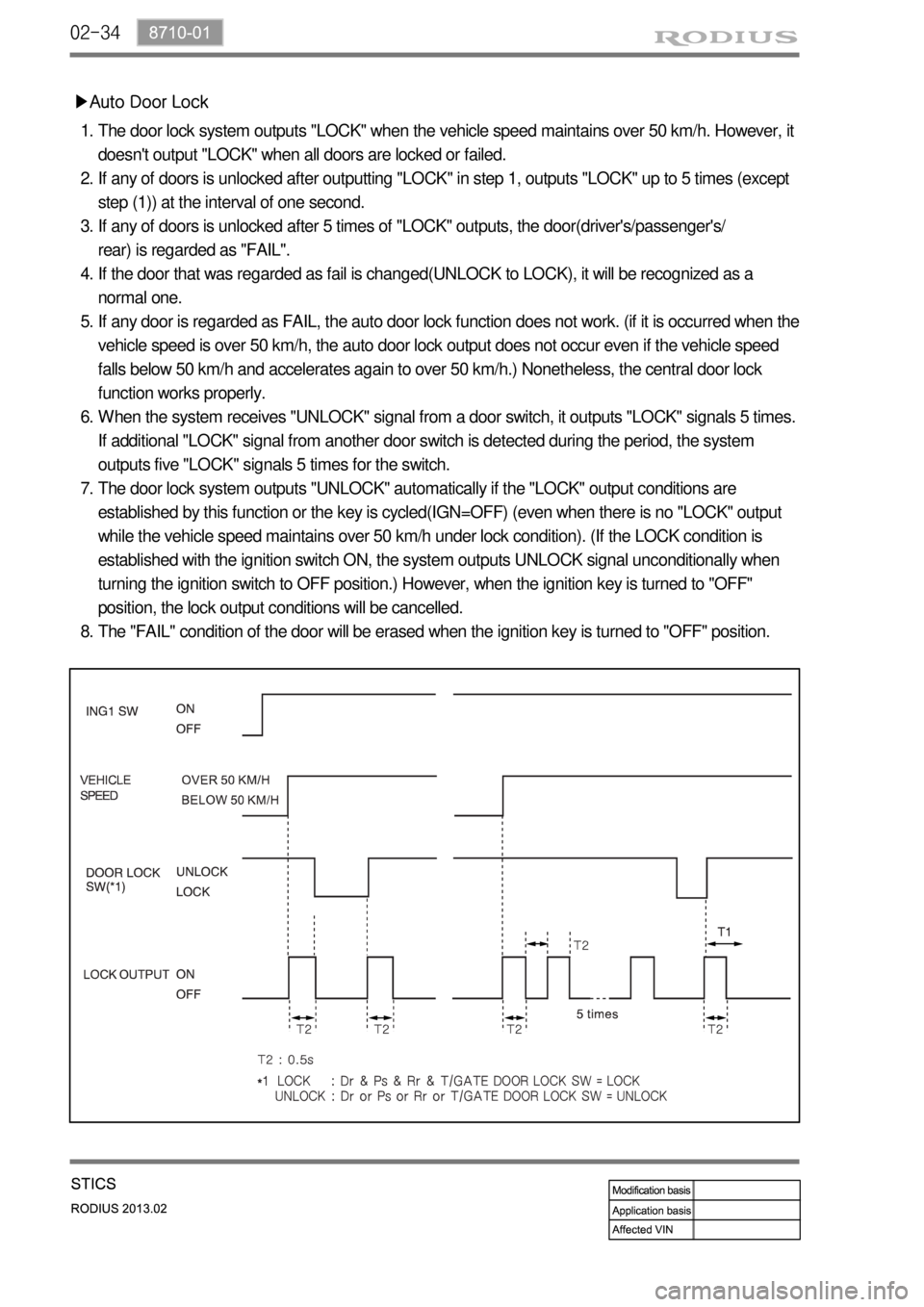
02-34
▶Auto Door Lock
The door lock system outputs "LOCK" when the vehicle speed maintains over 50 km/h. However, it
doesn't output "LOCK" when all doors are locked or failed.
If any of doors is unlocked after outputting "LOCK" in step 1, outputs "LOCK" up to 5 times (except
step (1)) at the interval of one second.
If any of doors is unlocked after 5 times of "LOCK" outputs, the door(driver's/passenger's/
rear) is regarded as "FAIL".
If the door that was regarded as fail is changed(UNLOCK to LOCK), it will be recognized as a
normal one.
If any door is regarded as FAIL, the auto door lock function does not work. (if it is occurred when the
vehicle speed is over 50 km/h, the auto door lock output does not occur even if the vehicle speed
falls below 50 km/h and accelerates again to over 50 km/h.) Nonetheless, the central door lock
function works properly.
When the system receives "UNLOCK" signal from a door switch, it outputs "LOCK" signals 5 times.
If additional "LOCK" signal from another door switch is detected during the period, the system
outputs five "LOCK" signals 5 times for the switch.
The door lock system outputs "UNLOCK" automatically if the "LOCK" output conditions are
established by this function or the key is cycled(IGN=OFF) (even when there is no "LOCK" output
while the vehicle speed maintains over 50 km/h under lock condition). (If the LOCK condition is
established with the ignition switch ON, the system outputs UNLOCK signal unconditionally when
turning the ignition switch to OFF position.) However, when the ignition key is turned to "OFF"
position, the lock output conditions will be cancelled.
The "FAIL" condition of the door will be erased when the ignition key is turned to "OFF" position. 1.
2.
3.
4.
5.
6.
7.
8.
Page 571 of 796
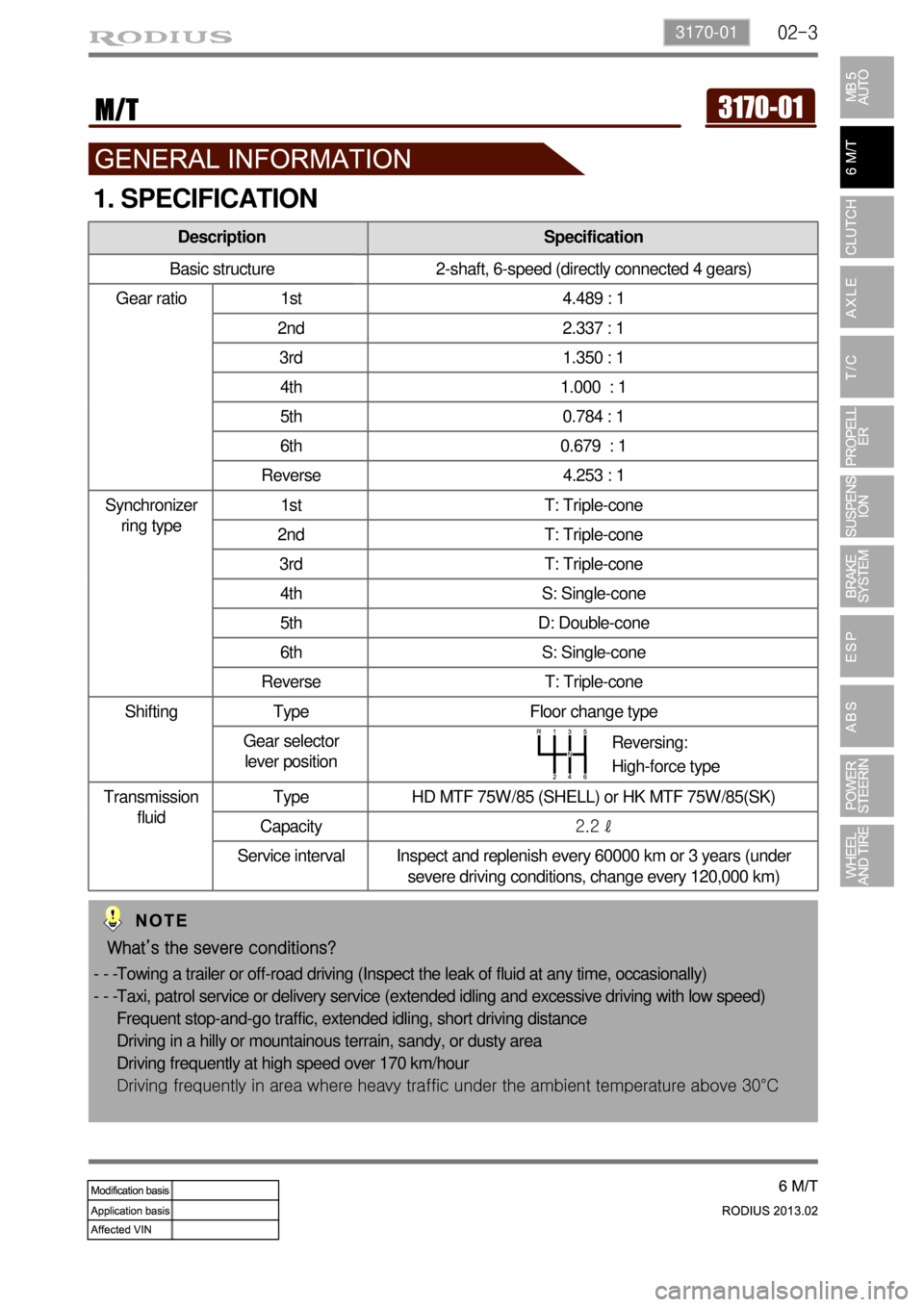
02-33170-01
Description Specification
Basic structure 2-shaft, 6-speed (directly connected 4 gears)
Gear ratio 1st 4.489 : 1
2nd 2.337 : 1
3rd 1.350 : 1
4th 1.000 : 1
5th 0.784 : 1
6th 0.679 : 1
Reverse 4.253 : 1
Synchronizer
ring type1st T: Triple-cone
2nd T: Triple-cone
3rd T: Triple-cone
4th S: Single-cone
5th D: Double-cone
6th S: Single-cone
Reverse T: Triple-cone
Shifting Type Floor change type
Gear selector
lever position
Transmission
fluidType HD MTF 75W/85 (SHELL) or HK MTF 75W/85(SK)
Capacity2.2 ℓ
Service interval Inspect and replenish every 60000 km or 3 years (under
severe driving conditions, change every 120,000 km)
1. SPECIFICATION
Reversing:
High-force type
What’s the severe conditions?
Towing a trailer or off-road driving (Inspect the leak of fluid at any time, occasionally)
Taxi, patrol service or delivery service (extended idling and excessive driving with low speed)
Frequent stop-and-go traffic, extended idling, short driving distance
Driving in a hilly or mountainous terrain, sandy, or dusty area
Driving frequently at high speed over 170 km/hour
Driving frequently in area where heavy traffic under the ambient temperature above 30°C - - -
- - -
Page 593 of 796

03-73010-00
1. OVERVIEW
The hydraulic clutch transmits the force required to operate the clutch pedal to the concentric slave
cylinder fitted to the clutch housing as a hydraulic pressure.
(The hydraulic pressure is transmitted in the following order: Clutch pedal - Clutch master cylinder -
Clutch pipe - Clutch damper - Clutch pipe and hose - Concentric slave cylinder - Pressure plate -
Flywheel.)
If a driver depress the clutch pedal, the hydraulic pressure is generated in the master cylinder. It is
transmitted to the concentric slave cylinder through the pipe, resulting in the cylinder being forced out.
At this time, the clutch disc is forced against the cylinder by pushing the cover. This, in turn, remove the
flywheel from the pressure plate. As a consequence, the power from the engine will be cut off and the
gear change can be carried out.
Page 639 of 796

08-12
Let the engine run for 1 to 2 minutes and
stop it. If the brake pedal stroke is shortened
as pumping the brake pedal, the system is
normal. If not, the system is defective. 1.
Depress the brake pedal several times with
engine off. If the brake goes down when
starting engine with pedal depressed, the
system is normal. If not, the system is
defective. 2.
If the above three checks are OK, the system is
normal. If any condition is not met, check the
valve, vacuum hose and brake booster.
3) Brake Booster
OK
NG
Engine stopped
Engine running
Depress the brake pedal when the engine is
running. If the pedal height is not changed
for 30 seconds after stopping the engine, the
system is normal. If not, the system is
defective. 3.
Page 653 of 796
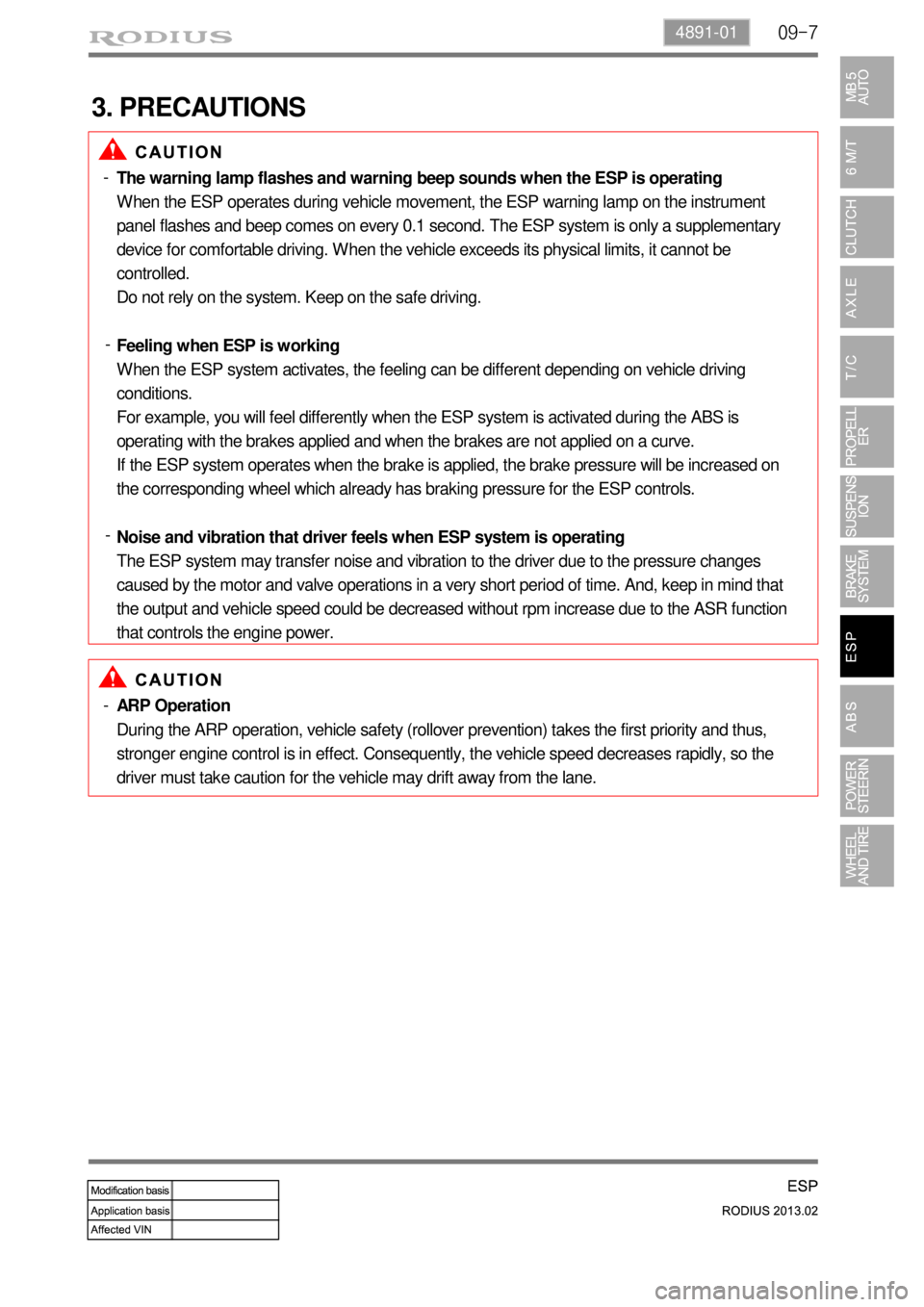
09-74891-01
3. PRECAUTIONS
The warning lamp flashes and warning beep sounds when the ESP is operating
When the ESP operates during vehicle movement, the ESP warning lamp on the instrument
panel flashes and beep comes on every 0.1 second. The ESP system is only a supplementary
device for comfortable driving. When the vehicle exceeds its physical limits, it cannot be
controlled.
Do not rely on the system. Keep on the safe driving.
Feeling when ESP is working
When the ESP system activates, the feeling can be different depending on vehicle driving
conditions.
For example, you will feel differently when the ESP system is activated during the ABS is
operating with the brakes applied and when the brakes are not applied on a curve.
If the ESP system operates when the brake is applied, the brake pressure will be increased on
the corresponding wheel which already has braking pressure for the ESP controls.
Noise and vibration that driver feels when ESP system is operating
The ESP system may transfer noise and vibration to the driver due to the pressure changes
caused by the motor and valve operations in a very short period of time. And, keep in mind that
the output and vehicle speed could be decreased without rpm increase due to the ASR function
that controls the engine power. -
-
-
ARP Operation
During the ARP operation, vehicle safety (rollover prevention) takes the first priority and thus,
stronger engine control is in effect. Consequently, the vehicle speed decreases rapidly, so the
driver must take caution for the vehicle may drift away from the lane. -